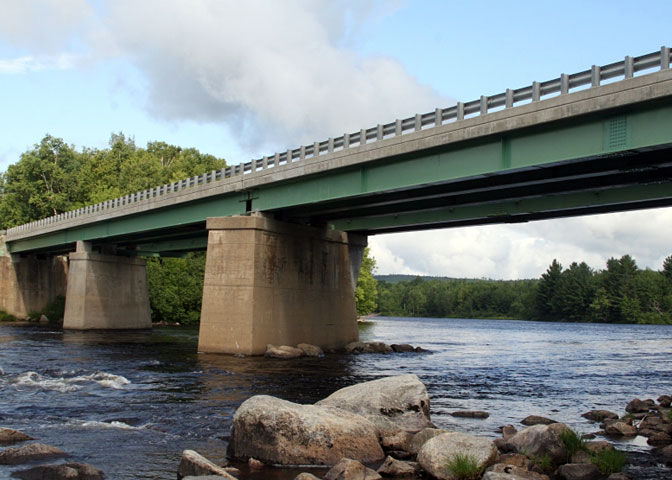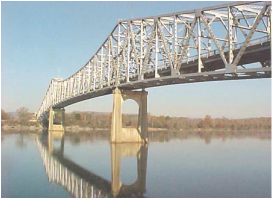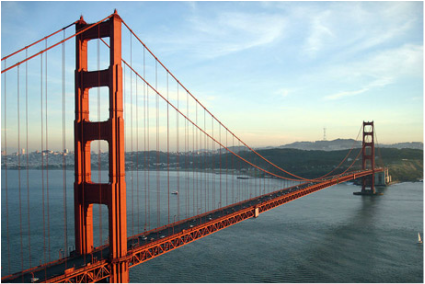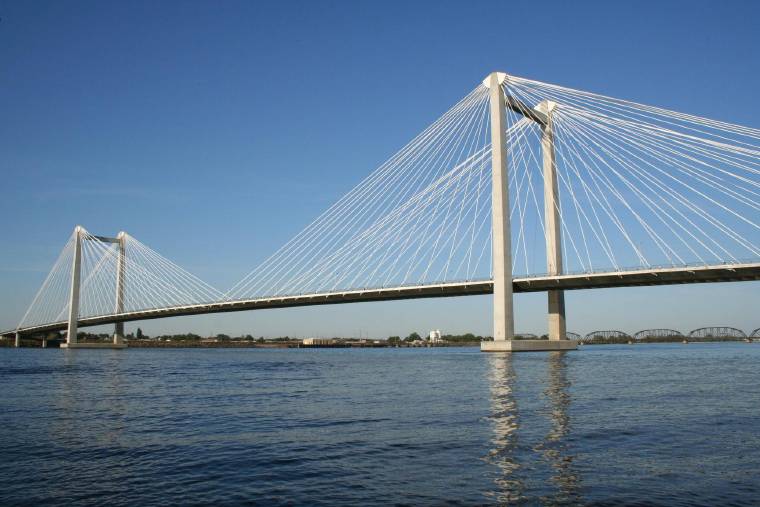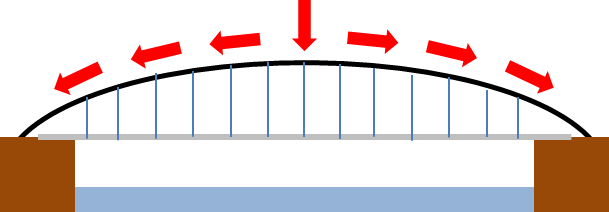|
One of the oldest engineering problems of humanity is how to get to the other side of a river, gorge or any particular gap-based obstacle. Needless to say one of the oldest professions out there is therefore the humble engineer, a job with probably the most overlooked impact to our lives.
This article wouldn't explain everything involved in bridge-building, but it explains enough to that the next time you came across a civil engineer you might get an idea of how he or she thinks in terms of problem solving. |
"A great bridge is a great monument which should serve to make known the splendour and genius of a nation; one should not occupy oneself with efforts to perfect it architecturally, for taste is always susceptible to change, but to conserve always in its form and decoration the character of solidity which is proper." - Jean Peronnet
If there’s one thing an average person can think about when he or she imagined an engineer it would be a bridge. As mentioned in one of our first articles, civil engineering came out of the need to solve real world problems, and logistics would probably be the first of these as human civilisation began to advance.
It’s not surprising as the first of our civilisations tend to sprout around rivers, such as those of Mesopotamia, the Indus Valley, or Egypt. This old problem is a continuous one as civilization progressed, along with new demands on structural integrity. A few centuries ago a simple wooden or stone construction would suffice to handle the traffic of pedestrians and horse carriages. Now we need them to handle container trucks, construction machineries and trains. But of course, this is engineering, and thus we want the most results with the least amount of resources, which led to the topic of the day.
Options
The fundamental principle of bridgework is a trade-off between loadbearing strength, amount of materials and structural integrity. The first is rather straight-forward, we need the bridge to carry as much a load as possible, especially considering future needs. The second is economic in nature, more or better materials may make a better bridge, but at higher costs. The third also relates to the first and second, as the more materials are used, the heavier it is, which may lead to structural failure. But if it’s too light, it will be too sensitive to its environs, case-in-point, the Tacoma Narrows Bridge.
Thus we have to look at our options, in terms of design and materials. Simple enough, but physics is never is.
It’s not surprising as the first of our civilisations tend to sprout around rivers, such as those of Mesopotamia, the Indus Valley, or Egypt. This old problem is a continuous one as civilization progressed, along with new demands on structural integrity. A few centuries ago a simple wooden or stone construction would suffice to handle the traffic of pedestrians and horse carriages. Now we need them to handle container trucks, construction machineries and trains. But of course, this is engineering, and thus we want the most results with the least amount of resources, which led to the topic of the day.
Options
The fundamental principle of bridgework is a trade-off between loadbearing strength, amount of materials and structural integrity. The first is rather straight-forward, we need the bridge to carry as much a load as possible, especially considering future needs. The second is economic in nature, more or better materials may make a better bridge, but at higher costs. The third also relates to the first and second, as the more materials are used, the heavier it is, which may lead to structural failure. But if it’s too light, it will be too sensitive to its environs, case-in-point, the Tacoma Narrows Bridge.
Thus we have to look at our options, in terms of design and materials. Simple enough, but physics is never is.
|
Beam Bridges
Perhaps the oldest type of bridge design is the beam, nothing is simpler than what is essentially a plank. The catch is that most of the load bearing stress is centred in the middle and this may lead to buckling. |
Arch Bridges
Second oldest, and probably the most historically significant, in no small part to the Romans. The arch was designed to ease the burden of the beam by shifting the stress from the middle to both ends of the bridge. This is when things became more sophisticated, and multiple types of arches were developed to fit specific needs, whether technical or economic. |
Strut Bridges
The third type is a compromise between the two. The beam is good at concentrating stress at certain areas, and the arch disperses the stress in whatever direction it’s designed for. Thought it seems to be intuitively better, struts are only as strong as their joints, a weak one would fail catastrophically, and they’re not at all that flexible. Hence… |
|
Suspension Bridges
If we’re going big, we need to recognize that the elements would not cooperate. Man have to sway to nature’s will, and sway we did – with the suspension bridge. Rigid structures don’t partner well with winds and earthquakes, so engineers suspended the roadway to allow for corrections. All those forces borne by the suspension cables are directed on either end, but unlike those before, rather than channeling the forces towards the ground, they anchor it onto some dead weight, which could be something as simple as a rock or a concrete foundation strengthened with pilings. |
Cable-Stayed Bridges
A form of suspension bridges, increasingly popular with engineers nowadays are cable-stayed bridges. Rather than anchoring the cables to some massive weight at either end (which may take up space and requires extensive excavation work), the cables are suspended directly onto a supporting pillar, which can either direct the force directly onto the ground or act as a counterweight through the clever use of physics. They’re a bit more complicated, but is certainly something to behold. |
The Ultimate Bridge
So if we were to build the ultimate bridge, what would that entail? Integrity would certainly be the main issue, but then there are also weight and therefore material costs, as well as flexibility to environmental changes. Assuming we’re not gunning for trade-offs, there’s only one way to have all of this: design.
The arch provides us with a clue on how best to achieve this, that is, stress distribution. Just like lying on a bed of nails, the wider you spread the force the less concentrated it’ll be on any particular area, and the less chance the bridge will fail. Couple this with the principles behind the suspension bridge, and we’d have something akin to a bow, with less cables and therefore less materials and therefore maintenance work. We just killed two birds with one stone.
So if we were to build the ultimate bridge, what would that entail? Integrity would certainly be the main issue, but then there are also weight and therefore material costs, as well as flexibility to environmental changes. Assuming we’re not gunning for trade-offs, there’s only one way to have all of this: design.
The arch provides us with a clue on how best to achieve this, that is, stress distribution. Just like lying on a bed of nails, the wider you spread the force the less concentrated it’ll be on any particular area, and the less chance the bridge will fail. Couple this with the principles behind the suspension bridge, and we’d have something akin to a bow, with less cables and therefore less materials and therefore maintenance work. We just killed two birds with one stone.
So how can we improve on that premise? A bridge only have two ends, no? Not exactly. In a traditional arch the weight of the bridge is borne along the sides of wherever you attached the supporting structures to. This is rather wasteful, in my humble opinion. All those trusses linking the two adds unnecessary weight. Now we must draw on physics to help. If you can recall the cantilever bridge design, the one that tilts and uses it’s own weight to support its load, we can therefore use this principle as a substitute to minimize the number of trusses by having the arches on both sides leaning against one another. Turning what was essentially two arches each having two ends into a single, four ended arch. Clever, huh?
Now the final issue for us to address is how to ensure it’s flexibility in the event of a gale wind or worse, an earthquake. For one we can have the point where the two arches meet to slide, but this also means we have to do the same with all the trusses connecting the two. Since most of the bridge’s load and surface area comes from the roadway, then this should be our main target to solve this problem.
The collapse of the Tacoma Narrows Bridge in 1940 provides us with a lesson on how to deal with this very problem. As it was originally designed, the roadway was built as a single solid surface, thus resisting airflow which led to its collapse. So now we know that we have to surrender to nature and let the wind go wherever it wants.
The second lesson comes from the resonating motion. The wind may have been the culprit that started this wild swaying, but the design is also flawed as it show that the roadway is too rigidly built. This is very much like a skyscraper with no dampening system, even the most solidly built building (and bridge) have a breaking point. So now the solution comes in the form of a ‘floating’ roadway, where it is supported, but not physically linked by the ends. This ensures that our bridge have the flexibility to give in to swaying as a result from a crosswind or even an earthquake.
So there it is, though these are just the broad principles. A bona fide civil engineer would take this and run them through with greater detail. Physics just barely scratched the surface of civil engineering, chemistry comes to play as and when better materials are developed such as ultra-high-tensile steel, and carbon nanotube strengthened concrete. The bridges of the future may not be recognizable to us and may even appear gravity-defying. We’re walking down the road to a brave new world, and the engineers, more than anyone else, will take us there.
The collapse of the Tacoma Narrows Bridge in 1940 provides us with a lesson on how to deal with this very problem. As it was originally designed, the roadway was built as a single solid surface, thus resisting airflow which led to its collapse. So now we know that we have to surrender to nature and let the wind go wherever it wants.
The second lesson comes from the resonating motion. The wind may have been the culprit that started this wild swaying, but the design is also flawed as it show that the roadway is too rigidly built. This is very much like a skyscraper with no dampening system, even the most solidly built building (and bridge) have a breaking point. So now the solution comes in the form of a ‘floating’ roadway, where it is supported, but not physically linked by the ends. This ensures that our bridge have the flexibility to give in to swaying as a result from a crosswind or even an earthquake.
So there it is, though these are just the broad principles. A bona fide civil engineer would take this and run them through with greater detail. Physics just barely scratched the surface of civil engineering, chemistry comes to play as and when better materials are developed such as ultra-high-tensile steel, and carbon nanotube strengthened concrete. The bridges of the future may not be recognizable to us and may even appear gravity-defying. We’re walking down the road to a brave new world, and the engineers, more than anyone else, will take us there.
Ponder this
Why do we still use different kinds of bridges? Is it purely for aesthetic reasons? If the only purpose of a bridge is to link two points across a body of water or gorge the a single, reliable, and proven design would be enough, no?
Bridge building capitalizes on the forces of tension and compression, can these two forces be used in synergy in a single design? How would that bridge look like?
Discuss
Engineers who design structures must completely understand the problem to be solved, which includes the complexities of the site and the customer needs. To design for safety and longevity, engineers consider the different types of loads, how they are applied and where. Engineers often aim for a design that is strongest and lightest possible—one with the highest strength-to-weight ratio.
What elements would a civil engineer look for before designing a bridge? Test each other on whether there are enough information to even begin considering things like bridge types, materials, loads, and the costs and benefits of each elements discussed.
Further readings
Bridge Design & Engineering, a resourceful magazine on the topic (surprising, I know!)
Civil Structures: Introduction to Bridge Engineering, another detailed resource about this particular branch of civil engineering


